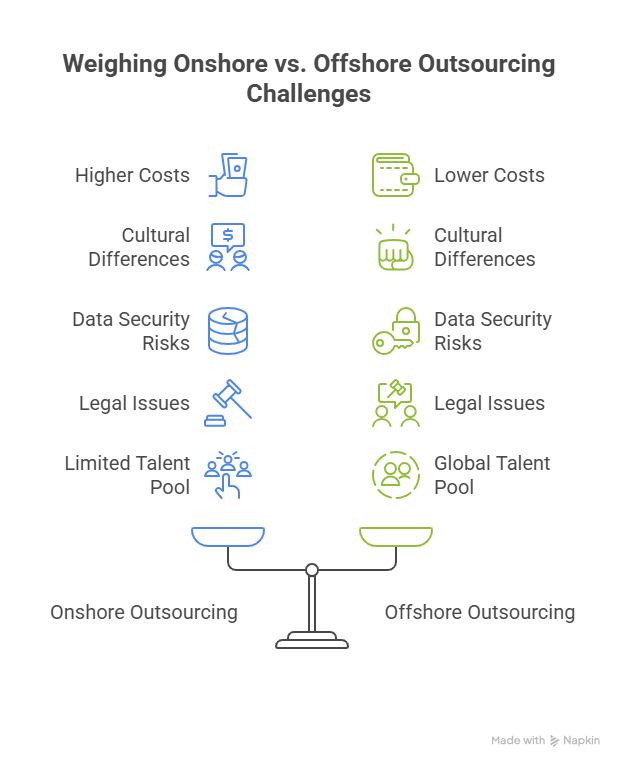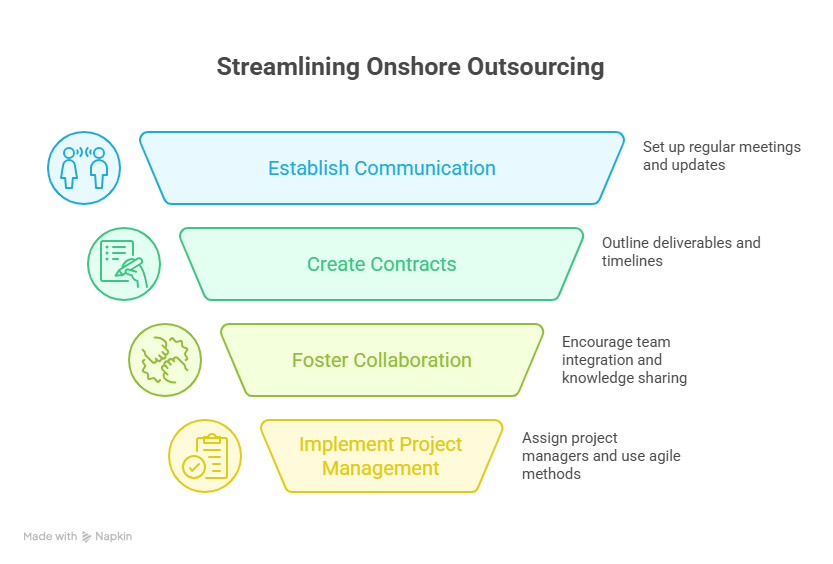Onshore Outsourcing: The Ultimate Guide
19 Jul 2023 By: Michael Kansky
Updated
Nearly 54% of US firms outsource customer service to boost performance. Onshore outsourcing, or delegating tasks to local firms, can enhance operations but poses challenges. Picking the right partner is crucial. Read on to learn about onshore outsourcing here.

Key Takeaways
What is onshore outsourcing?
Outsourcing lets your team focus on what they do best by handling routine tasks or ones outside their expertise. It keeps leaders on track with main goals and simplifies management, especially when you choose local partners.
Here are some common onshore outsourcing services:
- Managed (information technology) services
- Software development
- DevOps
- Financial services
- Marketing services
- Quality assurance testing
- Legal processes
- Customer care
Advantages of Onshore Outsourcing
Working with local companies offers lots of perks for your business. Here’s why:
- Proximity and Time Zone Advantage
Onshore outsourcing means that partner companies are close together. They will often work within the same or similar time zones. Their regular working hours will likely overlap. This makes internal communication easier, supports collaboration, and speeds up response times.
- Cultural Fit and Language Compatibility
Choosing an onshore partner usually means reduced cultural differences. For example, hiring often eliminates language barriers. That makes communication more effective and efficient and helps maintain brand consistency.
- Quality Control and Communication
Businesses can oversee onshore partners better than they can offshore partners. Managers have more control over the quality of work and can perform on-site visits more often. This can help to overcome any communication barriers and make instructions clear.
- Compliance and Legal Considerations
Onshore outsourcing improves adherence to local laws. In particular, it promotes labor regulations and data-protection standards. This reduces noncompliance and legal complications and avoids data breaches.
- Boosting the Local Economy and Community
Onshore outsourcing gives a lift to our local economies. That’s because it creates domestic jobs and supports local businesses. The country’s business environment also benefits from stability, workforce development, and social growth.
Challenges and Risks of Onshore Outsourcing
Even with its perks, hiring locally isn’t always the best move. Here are some major downsides to consider:

- Dealing with Higher Costs. Hiring within the US often costs more, given the higher wages compared to countries with cheaper labor costs.
- Managing Cultural and Communication Differences. Working with another company can mean differences in work culture. That introduces the potential for management conflicts. Communication and cultural differences can also exist even within the same country.
- Ensuring Data Security and Confidentiality. Letting other firms handle your private data comes with risks. Outsourcing even to onshore partners increases the risk of customer data breaches. Confidentiality may also be an issue if onshore partners work with local competitors.
- Mitigating Risks and Addressing Legal Issues. Working with outside companies leads to more business risk. More contracts can mean potential legal trouble. Limiting onshore outsourcing can mitigate these risks.
- Working with a Limited Talent Pool: Hiring only onshore companies can be limiting. This reduces access to expertise in offshore development centers. Onshore outsourcing may prevent companies from finding needed resources in the global pool.
Selecting best Onshore Outsourcing Partner
Businesses should carefully consider all onshore business process outsourcing (BPO) partners. Potential partners should be reliable and adhere to all legal requirements. Beyond that, parent companies should consider the following questions in finding onshore partners:
- Identify Business Requirements and Objectives
- What industries does the partner work with?
- What are the partner’s goals?
- What will the partner need from us?
- Check Reputation and Evidence of Success
- Does the partner have positive reviews?
- Does the partner have successful case studies?
- Do the partner’s clients recommend it?
- Assess Expertise and Experience in the Industry
- Is the partner familiar with our industry?
- Is the partner aware of our industry’s legal requirements?
- Does the partner ask questions to make sure they thoroughly understand the industry?
- Consider Location-Specific Factors
- In which time zone does the partner operate?
- What taxes are in place in the partner’s region?
- Does the partner have easy physical access to our teams?
Examples of Onshore Outsourcing
Onshore outsourcing is a common practice. Here are just two examples of onshore outsourcing at large companies:
- Delta Airlines: Based in Atlanta, GA, Delta contracted ServiceNow for HR tasks in 2019. When COVID-19 struck, ServiceNow swiftly created a COVID employee portal to address employee inquiries. Consequently, ServiceNow developed systems more efficiently than Delta could have achieved.
Microsoft Xbox: Headquartered in Washington State, Xbox hired AMP Agency for marketing services. AMP provided Xbox with web development, content planning, and illustration services. It also relieved Xbox’s call centers with its online solution.
Best Practices for Successful Onshore Outsourcing

1. Define Clear Objectives and Expectations
Start by identifying specific goals and outcomes. Make sure they align with your company’s business strategy.
2. Establish Effective Communication Channels
Regular meetings and status updates will be vital. The more often you check in, the more likely you are to stay aligned. There are many collaboration tools available to you. Find the one best for your team.
3. Define a Comprehensive Contract and SLAs
Outline deliverables, timelines, and milestones at the beginning of your partnership. Be specific. This will include signing a service level agreement (SLA). The SLA will establish performance metrics and quality standards for your outsourcing partner to refer to.
4. Foster Strong Collaboration and Integration
Don’t silo your in-house and outsourced teams. Encourage knowledge sharing and cross-team cooperation. This will promote a sense of partnership and shared goals.
5. Implement a Robust Project Management Framework
Assign dedicated project managers from within your organization. Give your in-house team ownership of the outsourced work. Make sure these leaders understand and use agile methodologies and effective coordination principles.
Onshore Outsourcing Cost

Hiring locally usually costs more than outsourcing abroad. U.S. workers earn higher wages—for instance, a tech support rep in the U.S. gets about $55,669 annually, compared to $422 to $533 in the Philippines. Plus, overhead and infrastructure costs are steeper too.
Onshore vs. Offshore Outsourcing
Yet, going offshore just to save money isn’t always smart. Offshore outsourcing can have hidden costs that you don’t face when hiring locally.
- Language and Cultural Barriers: Language and cultural differences can make offshore outsourcing tricky. Even speaking the same language doesn’t avoid the misunderstandings that cultural gaps can bring.
- Quality Control: The more miles between you and your outsourcing partner, the harder it is to keep an eye on quality.
- Legal Regulations:Going offshore means juggling two sets of laws, with all the fines and penalties for slipping up.
Onshore outsourcing FAQ
Conclusion
Onshore outsourcing means giving business tasks to outside firms in the same country. It has its advantages and disadvantages.
Advantages:
- Cultural and language affinity: Working with local firms means fewer language and culture clashes, as everyone shares the same background.
- Proximity: Hiring local companies makes working together, coordinating, and visiting in person easier than with overseas firms.
- Legal and regulatory knowledge: Hiring within your country usually means you’ll follow local laws and protect ideas better.
Disadvantages:
- Cost considerations: Usually, hiring locally costs more because wages and living costs are higher in developed places.
- Limited talent pool: In some places, there might not be many experts or the right kind of skills for your project, limiting your options.
- Scalability challenges:If you need a lot of people, hiring locally might not scale up as easily as hiring from abroad.
Choosing local outsourcing depends on costs, what the project needs, how sensitive the data is, and if cultural fit matters. Each business must weigh these and see if it meets their goals.


